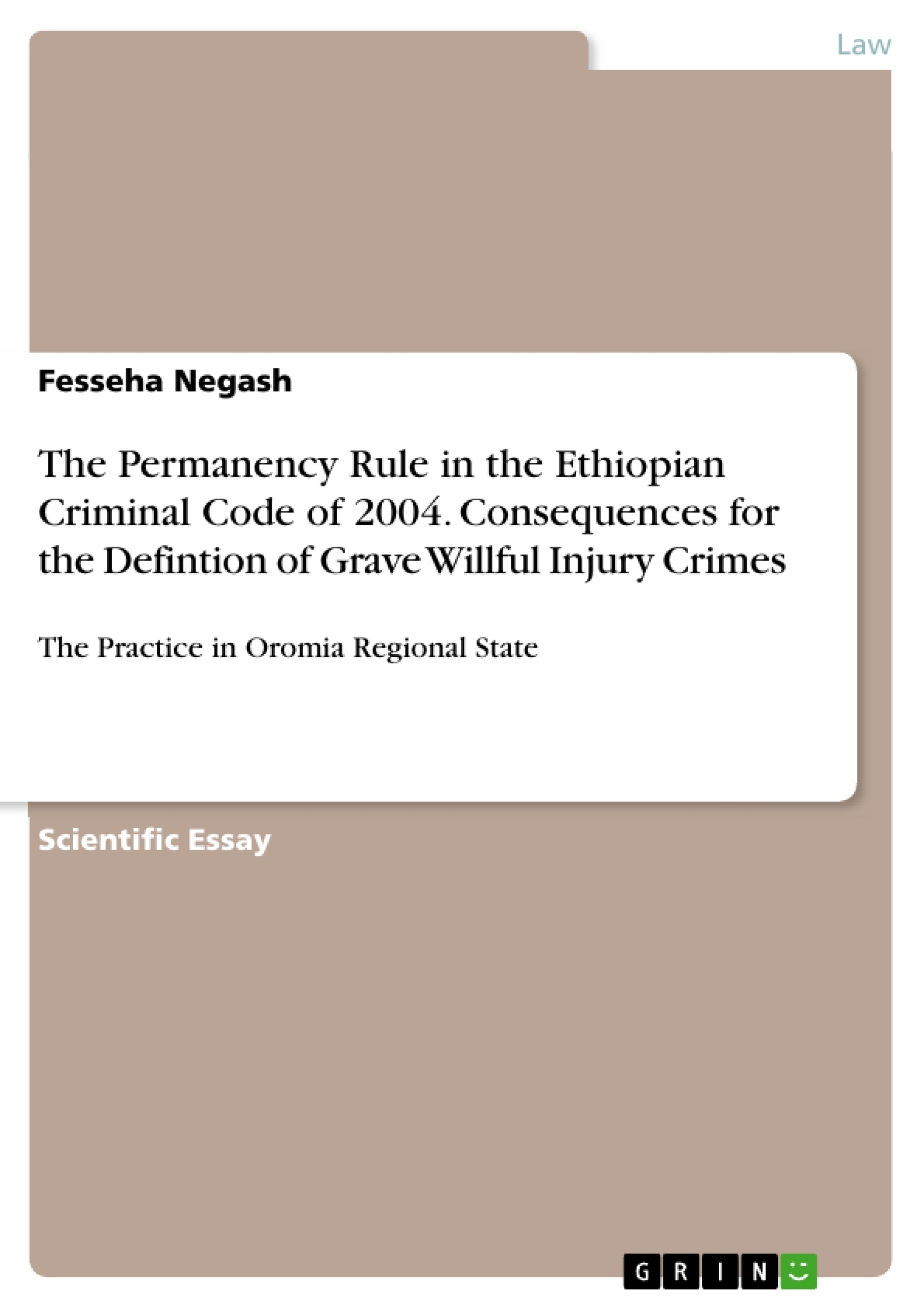This scientific essay deals with the Ethiopian criminal code of 2004 and its problematic definition of bodily injury crimes due to the permanency rule.
Act of bodily injury is commonly understood as crime against physical integrity and human dignity. Nonetheless, assessing different jurisdictions’ experiences reveals, though they have some criteria in common, they employ different standards and criteria to define what constitutes bodily injury crime and to classify bodily injury crimes, particularly into grave bodily injury crimes and other types of bodily injury crimes.
Ethiopian criminal code of 2004 covers crime of bodily injury in its chapter II of book V under a caption "crimes against person and health". It is verbatim copy of chapter 2 of book V of Ethiopian penal code of 1957. Though, even closing the eyes to historical glimpse, since 1957 inflicting any kind of bodily injury is crime against person and health, reviewing practices point out that there is no well established jurisprudence to define and to classify bodily injury crimes into grave willful injury crime and other kind of bodily injury crimes.
Table of Contents
- Introduction
- Of Injury
- Grave Bodily Injury Crime
- Grave Bodily Injury Crime Under Ethiopian Criminal Code of 2004
- FDRE Supreme Court Cassation Division's Jurisprudence on Grave Willful Injury Crime
- The Practice of Grave Willful Injury Crime in ORS
- Analysis of the Practice in ORS
Objectives and Key Themes
This paper aims to analyze the application of the "permanency rule" in determining grave willful injury crime in Oromia Regional State (ORS), Ethiopia, with particular focus on its consistency with the Ethiopian Criminal Code of 2004 and relevant jurisprudence.
- Bodily injury crime in Ethiopian law
- The concept of grave bodily injury crime across jurisdictions
- The permanency rule as a criterion for grave willful injury crime
- Application of the permanency rule in ORS
- Analysis of the practice in ORS in light of Ethiopian law and jurisprudence
Chapter Summaries
- Introduction: This section provides a general overview of the topic, highlighting the absence of a universally accepted definition and classification of bodily injury crimes, particularly grave bodily injury crime. The "permanency rule" is introduced as a contentious argument used to determine grave willful injury crime.
- Of Injury: This section examines the concept of "injury" from various legal and clinical perspectives. It defines injury as physical damage to a person's body, categorized by its severity. The section emphasizes that "actual bodily harm" is a key concept, excluding psychological harm.
- Grave Bodily Injury Crime: This section explores the definition of grave bodily injury crime in various jurisdictions, highlighting the lack of a global standard despite shared elements. It provides examples from the Model Penal Code of America to illustrate different approaches to defining and classifying assault and bodily injury.
- Grave Bodily Injury Crime Under Ethiopian Criminal Code of 2004: This section examines the Ethiopian Criminal Code of 2004's definition of grave bodily injury crime. It concludes that the Code only recognizes actual physical injury and emphasizes that permanency is not the sole criterion for designating a grave willful injury crime.
- FDRE Supreme Court Cassation Division's Jurisprudence on Grave Willful Injury Crime: This section analyzes the jurisprudence of the Federal Supreme Court Cassation Division, concluding that it also recognizes other serious injuries, beyond those causing permanent health difficulties, as grave willful injury crimes.
- The Practice of Grave Willful Injury Crime in ORS: This section focuses on the practice in Oromia Regional State (ORS) and the stance of the ILQSO (Oromia Justice Sector Professionals Training and Legal Research Institute). It argues that the practice in ORS, mirroring the ILQSO's stance, relies solely on the "permanency rule," which is inconsistent with the law.
- Analysis of the Practice in ORS: This section analyzes the practice in ORS in light of the Ethiopian Criminal Code of 2004 and the Federal Supreme Court Cassation Division's jurisprudence, highlighting the inconsistencies.
Keywords
Key terms and concepts explored in this paper include bodily injury crime, grave willful injury crime, permanency rule, Ethiopian Criminal Code of 2004, Oromia Regional State, and the jurisprudence of the Federal Supreme Court Cassation Division.
- Quote paper
- Fesseha Negash (Author), 2021, The Permanency Rule in the Ethiopian Criminal Code of 2004. Consequences for the Defintion of Grave Willful Injury Crimes, Munich, GRIN Verlag, https://www.grin.com/document/995335



